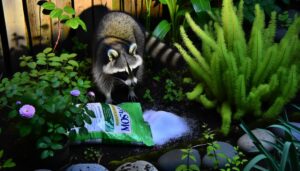Did Raccoons Get Their Name: Tracing the Roots
The name 'raccoon' derives from the Powhatan Algonquian term 'aroughcun,' which translates to 'one who scratches with its hands.' This terminology highlights the raccoon's characteristic tactile behavior and dexterity. Indigenous knowledge systems contributed extensively to the species' description and nomenclature through detailed observations.
Early European explorers adopted these descriptive terms, integrating them into their own languages. Over time, the name evolved linguistically, yet retained its original reference to the animal's behavior.
Modern usage universally recognizes 'raccoon' as the accepted term, reflecting a blend of indigenous insights and colonial documentation practices. To further explore this fascinating etymology…

Key Takeaways
- The name 'raccoon' originated from the Powhatan word 'aroughcun', meaning 'one who scratches with its hands'.
- Indigenous naming practices provided precise terminology based on raccoons' behavior and characteristics.
- Early European explorers documented raccoons, leading to the adoption of descriptive names like 'washing bear'.
- Language evolution integrated indigenous terms into colonial lexicons, standardizing 'raccoon' over time.
- Spelling variations like 'rahaugcum' and 'arathkone' eventually coalesced into the modern spelling 'raccoon'.
Native American Origins
The name 'raccoon' is derived from the Powhatan word 'aroughcun,' which describes the animal's habit of using its hands to manipulate objects and food. This nomenclature reflects the raccoon's distinctive behavioral trait of tactile exploration, a behavior facilitated by their highly sensitive forepaws.
These forepaws possess a dense concentration of sensory receptors, allowing raccoons to discern textures and shapes with remarkable precision. This dexterity is integral to their foraging strategy, enabling them to locate and process diverse food sources such as invertebrates, fruits, and small vertebrates.
The etymology underscores the intersection of linguistic heritage and the biological characteristics of the raccoon, illustrating how indigenous knowledge systems aptly capture the essence of local fauna through precise terminology.
Powhatan Influence
Powhatan influence on the naming of the raccoon highlights the intricate relationship between indigenous linguistic heritage and the biological characteristics of local wildlife.
The Powhatan people, a subgroup of the Algonquian-speaking tribes, referred to the raccoon as 'aroughcun.' This term encapsulates the animal's distinctive behaviors, such as its dexterous front paws used for foraging and washing food.
The nomenclature reflects a deep observational understanding of the raccoon's habits and ecological niche. This linguistic contribution has persisted through various transliterations, eventually forming the modern term 'raccoon.'
Such indigenous names provide more than mere labels; they offer insights into the symbiotic connections between native cultures and their natural environments, enriching our understanding of both language and biodiversity.
Algonquian Language Roots
Intriguingly, the term 'raccoon' has its etymological roots deeply embedded in the Algonquian language family, reflecting a rich tapestry of cultural and environmental interactions.
The Algonquian languages, spoken by various Indigenous tribes across North America, are known for their descriptive nature, particularly when naming fauna.
The word 'raccoon' is derived from the Powhatan word 'aroughcun,' which translates to 'one who scratches with its hands.' This term underscores the raccoon's distinctive foraging behavior, a trait that evidently resonated with the Algonquian speakers.
Meaning of "Aroughcun"
How does the term 'aroughcun' encapsulate the behavioral and ecological characteristics of the raccoon?
The word 'aroughcun,' derived from the Powhatan language, translates to 'one who scratches with his hands.' This term vividly captures the raccoon's distinctive behaviors and interactions with its environment. The term reflects several key traits:
- Dexterity: Raccoons possess highly dexterous front paws, enabling them to manipulate objects and access food sources.
- Foraging: Their omnivorous diet involves foraging behaviors, often involving intricate handling and examination of potential food items.
- Nocturnal Activity: Raccoons are primarily nocturnal, employing their keen sense of touch in low-light conditions.
- Adaptability: Their ability to thrive in diverse habitats, from urban areas to forested regions, showcases their ecological versatility.
These characteristics underscore the precision of the term 'aroughcun' in describing raccoons.
Early European Descriptions
Early European explorers documented their encounters with Procyon lotor, meticulously noting its distinctive features such as the dexterous forepaws and characteristic facial mask.
These initial observations led to descriptive names like 'washing bear' in reference to the raccoon's behavior of dousing food in water.
Such terminological choices were foundational in shaping the nomenclature of this North American mammal in various European languages.
First European Encounters
The initial European encounters with raccoons were meticulously documented by explorers, who provided detailed descriptions of the animal's distinctive physical characteristics and behaviors. These early observations laid the groundwork for further scientific inquiries and classifications.
Key attributes noted by the explorers included:
- Dexterous Forepaws: Explorers were fascinated by the raccoon's highly adaptable front paws, capable of manipulating objects with precision.
- Masked Facial Features: The distinct black mask-like markings around the eyes caught the attention of many early observers.
- Omnivorous Diet: Detailed accounts described their varied diet, which included fruits, nuts, insects, and small vertebrates.
- Nocturnal Activity: Explorers noted the raccoon's primarily nocturnal habits, observing their foraging and social behaviors at night.
These detailed accounts significantly contributed to the understanding and naming of the species.
Descriptive Animal Names
Building on these detailed observations, European explorers often assigned descriptive names to raccoons based on their notable physical traits and behaviors. Early descriptions emphasized their dexterous forepaws, masked facial markings, and nocturnal habits. Such detailed accounts facilitated a deeper understanding and accurate naming conventions. The term "racoon" evolved from the Algonquin word "arakun," which signifies "he scratches with his hands," reflecting their characteristic behavior.
| European Name | Descriptive Trait | Origin of Name |
|---|---|---|
| Waschbär | Washing bear | German |
| Mapache | One who takes everything | Spanish, from Nahuatl |
| Raton laveur | Washing rat | French |
| Racoon | He scratches with hands | English, from Algonquin |
These names underscore the intricate interplay between observation and nomenclature, aiding in the dissemination of zoological knowledge.
Adoption by Colonists
The adoption of the term 'raccoon' by European colonists was greatly influenced by early settlers' detailed observations of the animal's behavior and physical characteristics.
The integration of Native American languages, particularly from the Powhatan word 'aroughcun,' played an essential role in shaping its nomenclature.
Colonial documentation practices further solidified the term within scientific and common vernacular through systematic recording and dissemination.
Early Settlers' Observations
Early settlers meticulously documented their encounters with raccoons, noting the animals' distinctive behaviors and physical characteristics. Their observations were critical in shaping the early understanding of raccoon ecology. The settlers' records detailed the following attributes:
- Dexterous Forepaws: Noted for their tactile sensitivity and manipulative capabilities, raccoons used their forepaws to open shells, doors, and containers.
- Nocturnal Activity: Raccoons exhibited primarily nocturnal behavior, foraging for food during the night and resting during the day.
- Omnivorous Diet: Their diet included a broad spectrum of food items, from fruits and nuts to small vertebrates and invertebrates.
- Distinctive Facial Mask: The characteristic black 'mask' across their eyes was consistently highlighted, aiding in individual identification.
These detailed observations by early settlers played a pivotal role in the subsequent naming and classification of raccoons.
Influence of Native Languages
Among the many factors that influenced the nomenclature of raccoons, the linguistic contributions from various Native American tribes were particularly significant. Early colonists encountered the Algonquian term 'aroughcun,' translating to 'he scratches with his hands.' This term aptly described the animal's dexterous behavior and was subsequently adopted into English as 'raccoon.'
The colonists' interactions with indigenous peoples facilitated the transmission of such terminologies, reflecting a confluence of cultural and linguistic exchange. Additionally, the Powhatan word 'rahaugcum' similarly influenced the modern name. The adoption of these native terms exemplifies the profound impact of indigenous knowledge on colonial lexicons, underscoring the importance of interlinguistic communication in shaping scientific and common nomenclature.
This exchange advanced mutual understanding and enriched the settlers' descriptive vocabulary.
Colonial Documentation Practices
Colonial documentation practices played a pivotal role in formalizing the adoption of indigenous terminologies into the lexicon, as evidenced by the meticulous records maintained by settlers. These practices ensured the structured assimilation of native words, including the term 'raccoon,' derived from the Algonquian word 'aroughcun.'
The colonial record-keeping encompassed multiple facets:
- Linguistic Transcription: Accurate transcription of native words into the colonial language.
- Taxonomic Classification: Systematic classification of flora and fauna, incorporating native terminologies.
- Cultural Documentation: Detailed ethnographic records, preserving indigenous knowledge systems.
- Legal Codification: Integration of indigenous terms into legal and administrative documents.
These practices facilitated a thorough understanding and respectful integration of indigenous linguistic heritage into colonial society, reflecting a nuanced approach to cultural interchange.
Language Evolution
Linguistic transformations frequently occur as languages interact and evolve, often resulting in the assimilation of indigenous terms such as 'raccoon' into the lexicons of colonial settlers.
The term 'raccoon' is derived from the Powhatan word 'aroughcun,' demonstrating a phonological adaptation as European settlers incorporated Native American nomenclature. Such lexical borrowing is a hallmark of language evolution, wherein phonetic and semantic modifications render the original term accessible within the colonizers' linguistic framework.
This process underscores the dynamic and reciprocal nature of language development, which is heavily influenced by sociocultural exchanges. The integration of indigenous vocabulary into colonial languages not only facilitated communication but also preserved elements of native linguistic heritage, enhancing the linguistic diversity of the time.
First Recorded Usage
The earliest documented occurrence of the term 'raccoon' in English texts can be traced back to the early 17th century, specifically in the writings of English explorers and settlers. These records often reflect the initial encounters with the species Procyon lotor, highlighting their distinguishing characteristics and behaviors.
Four notable aspects include:
- Primary Sources: Early manuscripts and travel logs detailing observations of raccoons' behaviors and physical traits.
- Terminology: Usage of the term 'raccoon' within the context of fauna classification during that period.
- Cultural Exchange: Influence of Native American languages on the adoption and adaptation of the term by English speakers.
- Geographical Context: Areas of North America where explorers first documented raccoons, providing insight into their natural habitat and distribution.
These points collectively illustrate the term's etymological emergence.
Variations in Spelling
The nomenclature of the raccoon has exhibited notable historical spelling differences, reflecting its varied etymological origins.
Early European settlers recorded the name in forms such as 'rahaughcun' and 'arathkone,' each influenced by phonetic interpretations of indigenous terms.
Additionally, regional naming variations further contributed to the diverse lexical representations of the species across different linguistic and cultural landscapes.
Historical Spelling Differences
Throughout history, the spelling of the word 'raccoon' has undergone numerous variations, reflecting the linguistic influences and orthographic practices of different periods. These historical spellings provide insights into the evolution of the English language and the adaptation of Native American terms into European lexicons.
The primary differences can be categorized as follows:
- Early Colonial Period: Variations such as 'rahaugcum' and 'arathkone' were documented by early settlers, influenced by Algonquian languages.
- 18th Century: The spelling 'racoon' became more standardized, yet alternative forms like 'rakoon' persisted.
- 19th Century: Lexicographers began favoring 'raccoon,' aligning with more systematic English orthography.
- Modern Usage: The spelling 'raccoon' is now universally accepted, reflecting linguistic stabilization and standardization practices.
These variations underscore the dynamic interplay between linguistic evolution and cultural exchange.
Regional Naming Variations
Although the spelling of 'raccoon' has largely been standardized in modern English, regional variations still persist, reflecting localized linguistic preferences and historical influences. These spelling differences are often retained in regional dialects and vernaculars, contributing to the rich tapestry of linguistic diversity. For instance, historical documents and local literature reveal several alternative spellings.
| Region | Common Spelling Variations |
|---|---|
| Southern US | Rackoon |
| Appalachia | Raccoon |
| Midwest | Racoon |
| Canada | Racon |
| UK | Racoon |
Such variations are not merely orthographic curiosities but provide insight into the diffusion of language and cultural interchange. Understanding these differences enhances our appreciation of regional linguistic identities and strengthens our ability to serve diverse communities with sensitivity.
Influence of Linnaeus
Carl Linnaeus's pioneering work in taxonomy greatly influenced the naming and classification of raccoons, shaping our understanding of their place within the animal kingdom. His systematic approach to classifying organisms laid the groundwork for modern biological nomenclature. Linnaeus introduced the binomial nomenclature system, which assigned a two-part Latin name to each species, ensuring uniformity and clarity.
Key contributions include:
- Procyon lotor: Linnaeus named the raccoon Procyon lotor, highlighting its genus and species.
- Taxonomic Hierarchy: He placed raccoons within the family Procyonidae, recognizing their distinct characteristics.
- Morphological Assessment: Linnaeus's detailed morphological observations helped differentiate raccoons from similar species.
- Global Standardization: His work provided a universal framework for scientists worldwide to study and communicate about raccoons.
Modern Linguistic Changes
In recent decades, linguistic shifts and cultural influences have led to various common names and regional terms for raccoons, reflecting the dynamic nature of language and taxonomy.
The term 'raccoon' itself has given rise to colloquial variants such as 'coon' in certain dialects, although its usage is often scrutinized due to potential derogatory connotations.
Additionally, scientific nomenclature has evolved, incorporating genetic studies that identify subspecies, resulting in names like Procyon lotor and Procyon lotor hirtus.
Regional vernacular also diversifies, with terms such as 'mapache' in Spanish-speaking areas, derived from the Nahuatl word 'mapachitli.'
These linguistic variations underscore the adaptability of both language and scientific classification in response to cultural and regional influences.
Cultural Impact
The myriad linguistic variations not only reflect the dynamic nature of language but also highlight the significant cultural impact raccoons have had across different societies. This influence can be observed in various cultural domains:
- Folklore: Raccoons often appear as trickster figures in Native American myths, embodying both cleverness and mischief.
- Symbolism: In Japanese culture, raccoons, or 'tanuki,' are symbols of prosperity and good fortune.
- Literature: In Western literature, raccoons are frequently depicted as intelligent and resourceful creatures.
- Media: Modern media, including films and children's books, frequently feature raccoons, further embedding them into popular culture.
These examples underscore the raccoon's pervasive role in shaping cultural narratives and societal values across the globe.
Current Usage
Although raccoons have historically played significant roles in cultural narratives, their current usage spans various scientific fields, urban ecology studies, and wildlife management practices.
In scientific research, Procyon lotor serves as a model organism for studying adaptable behaviors and disease vectors, particularly zoonotic diseases like rabies.
Urban ecologists observe raccoons to understand human-wildlife interactions and habitat encroachment impacts.
Wildlife management practices utilize trapping and relocation strategies to mitigate conflicts between raccoons and urban populations. Additionally, raccoons are monitored to assess ecosystem health, given their role as both predator and scavenger.
Such multifaceted usage underscores the importance of raccoons in advancing ecological, epidemiological, and conservation knowledge, ultimately contributing to sustainable coexistence with human communities.
Conclusion
The etymology of the term 'raccoon' reveals a rich tapestry of linguistic evolution, beginning with Native American origins and Powhatan influences, and extending to Algonquian language roots.
The word 'aroughcun,' meaning 'he scratches with his hands,' encapsulates the animal's distinctive behavior. European naturalists, including Linnaeus, further shaped its nomenclature.
As language evolved, so did terminological precision, illustrating the adage, 'language is the dress of thought.'
Today, the term 'raccoon' encapsulates centuries of cultural and scientific influence.






